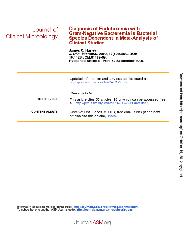Please use this identifier to cite or link to this item:
http://hdl.handle.net/11054/30| Title: | The diagnosis of endotoxemia with gram negative bacteremia is bacterial species dependent: a meta-analysis of clinical studies. |
| Authors: | Hurley, James C. |
| Issue Date: | 2009 |
| Publisher: | American Society for Microbiology |
| Place of publication: | Washington |
| Publication Title: | Journal of Clinical Microbiology |
| Volume: | 47 |
| Issue: | 12 |
| Start Page: | 3826 |
| End Page: | 3831 |
| Abstract: | Endotoxemia is undetectable for up to 60% of cases of bacteremia caused by gram-negative (GN) species, a discordance attributed to the limitations of the Limulus assay for endotoxemia. The lipid A structure of the endotoxin molecule is critical for the sensing of GN bacteria by the host immune system although not so for sensing by the Limulus assay. The lipid A structure of commensal Enterobacteriaceae is hexa-acyl, whereas non-Enterobacteriaceae have a broader range of structures. By using a previously published classification of lipid A structures (R. S. Munford, Infect. Immun. 76:454-465, 2008), the association of endotoxemia with bacteremia caused by GN organisms is reexamined for 580 GN bacteremic patients from 46 studies. Endotoxemia was less commonly detected for cases of bacteremia caused by Salmonella enterica serovar Typhi (four studies; 15 of 55 cases of bacteremia [27%]) than for cases of bacteremia caused by Neisseria meningitidis (five studies; 69 of 84 cases [82%]) and Pseudomonas pseudomallei (one study; 38 of 41 cases [93%]) among studies restricted to those with specified cases of bacteremia caused by GN organisms. Among 23 unrestricted studies, endotoxemia was less commonly detected for cases of bacteremia with a commensal member of the Enterobacteriaceae (104 of 240 cases [43%]) than with non-Enterobacteriaceae (59 of 100 cases [59%]) (summary odds ratio, 0.53 [90% confidence interval, 0.33 to 0.85]). This finding is consistent across all the unrestricted studies, even including studies with seemingly contrary results for endotoxemia diagnosis among cases of bacteremia caused by GN bacteria overall. Surprisingly, with bacteremia caused by commensal Enterobacteriaceae, the diagnosis of endotoxemia appears to be unrelated to the Limulus assay sensitivity. Across these 45 studies, the association of endotoxemia with GN bacteremia is variable but consistent for different types of GN bacteremia. |
| URI: | http://hdl.handle.net/11054/30 |
| Resource Link: | http://jcm.asm.org/content/47/12/3826.short |
| ISSN: | 0095-1137 |
| Internal ID Number: | 00017 |
| Health Subject: | META ANALYSIS ANIMALS BACTEREMIA - COMPLICATIONS BACTEREMIA - MICROBIOLOGY ENDOTOXEMIA - COMPLICATIONS ENDOTOXEMIA - DIAGNOSIS ENDOTOXEMIA - MICROBIOLOGY ENTEROBACTERIACEAE - CLASSIFICATION ENTEROBACTERIACEAE - ISOLATION AND PURIFICATION GRAM NEGATIVE BACTERIA - CLASSIFICATION GRAM NEGATIVE BACTERIA - ISOLATION AND PURIFICATION HORSESHOE CRABS HUMANS NEISSERIA MENINGITIDIS - ISOLATION AND PURIFICATION PSEUDOMONAS - ISOLATION AND PURIFICATION SALMONELLA TYPHI - ISOLATION AND PURIFICATION SPECIES SPECIFICITY |
| Type: | Journal Article Article |
| Appears in Collections: | Research Output |
Files in This Item:
| File | Description | Size | Format | |
|---|---|---|---|---|
| 00017.pdf | Reproduced with permission. | 201.03 kB | Adobe PDF |  View/Open |
Items in DSpace are protected by copyright, with all rights reserved, unless otherwise indicated.
